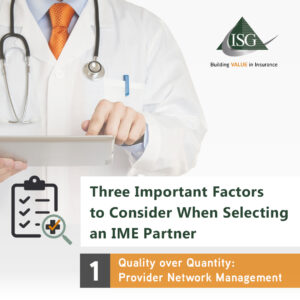 Part 1: Quality over Quantity: Provider Network Management
Part 1: Quality over Quantity: Provider Network Management
Independent medical examinations (IME) and medical reviews are an important tool used by claims professionals to help determine the next steps in a claim or injury management process. These evaluations are commonly used to determine injury causation, assess whether the recommended treatment path falls within occupational disability guidelines, determine disability status, or to evaluate an individual’s ability to return to work in light, modified or full capacity.
Engaging a third-party IME company can be a strategic way to demonstrate a claims organization’s own impartiality in the IME process. But how should a claims organization choose a strategic partner?
Three important things to consider when selecting an IME partner include:
- Quality of Provider Network and IME Reports
- Processes for Managing Appointments and Minimizing No Shows
- Personalized Customer Care: Technology and Administrative Support
In this three-part series, we’ll dive deeper into each of these considerations.
1. Quality of Provider Network and IME Reports
The first thing to consider when evaluating an IME partner is the quality of their provider network and IME reports. This begs the question, does network size matter?
The answer to this question is a resounding yes. And no. While the size of an IME network is important to ensure appropriate geographic coverage, it’s not the only factor to consider when evaluating an IME network. It’s also critical to evaluate the process by which providers in the network are vetted and how claims are matched to specific specialists capable of addressing the questions that need to be answered.
For example, the ISG physician network includes more than 16,000 providers across the United States, providing ample coverage in both urban and rural areas. Yet, more importantly, after each IME is completed, the physician’s report is rated as part of our quality management program.
The quality of the IME report is not only reviewed, but the results are catalogued in a system and used when making future referrals. With each referral received, a “smart match” process is utilized that includes selecting physicians based on their distance to the patient, specialty/sub-specialty, report quality and turnaround time.
Key metrics for measuring the quality of reports includes confirming that:
- Demographic information is correct.
- Case history is accurate.
- Medical records have been reviewed.
- Case objectives have been answered.
- Specific client questions are answered completely and thoroughly.
- Turnaround time expectations have been met.
- Jurisdictional guidelines have been followed.
- Supporting evidenced-based material is included.
At ISG, every report is reviewed by a quality assurance team comprised of nurses, paralegals and professionals with claims experience. Our review team reads each report and follows up with the reviewing physician if information is missing or clarification is needed. This process ensures a clear medical opinion is expressed that addresses all questions asked by claims staff.
Let’s now return to the question posed at the beginning of this article. Does size of the IME network matter? While quantity of providers is important, quality reigns supreme. Be sure to speak to your IME partner about their quality management process so you get the best results.
Key questions you should ask when evaluating an IME partner include:
- What is the size and geographic distribution of your IME network?
- How are providers in your network credentialed and managed to ensure quality?
- What is your quality assurance process?
- Is your program URAC accredited?
- What are your service level agreements and turnaround times?
Click here to read part two of our series as we examine the importance of processes for scheduling appointments and coordinating attendance. Reach out to an ISG Representative for more information at: customerservice@isgvalue.com



